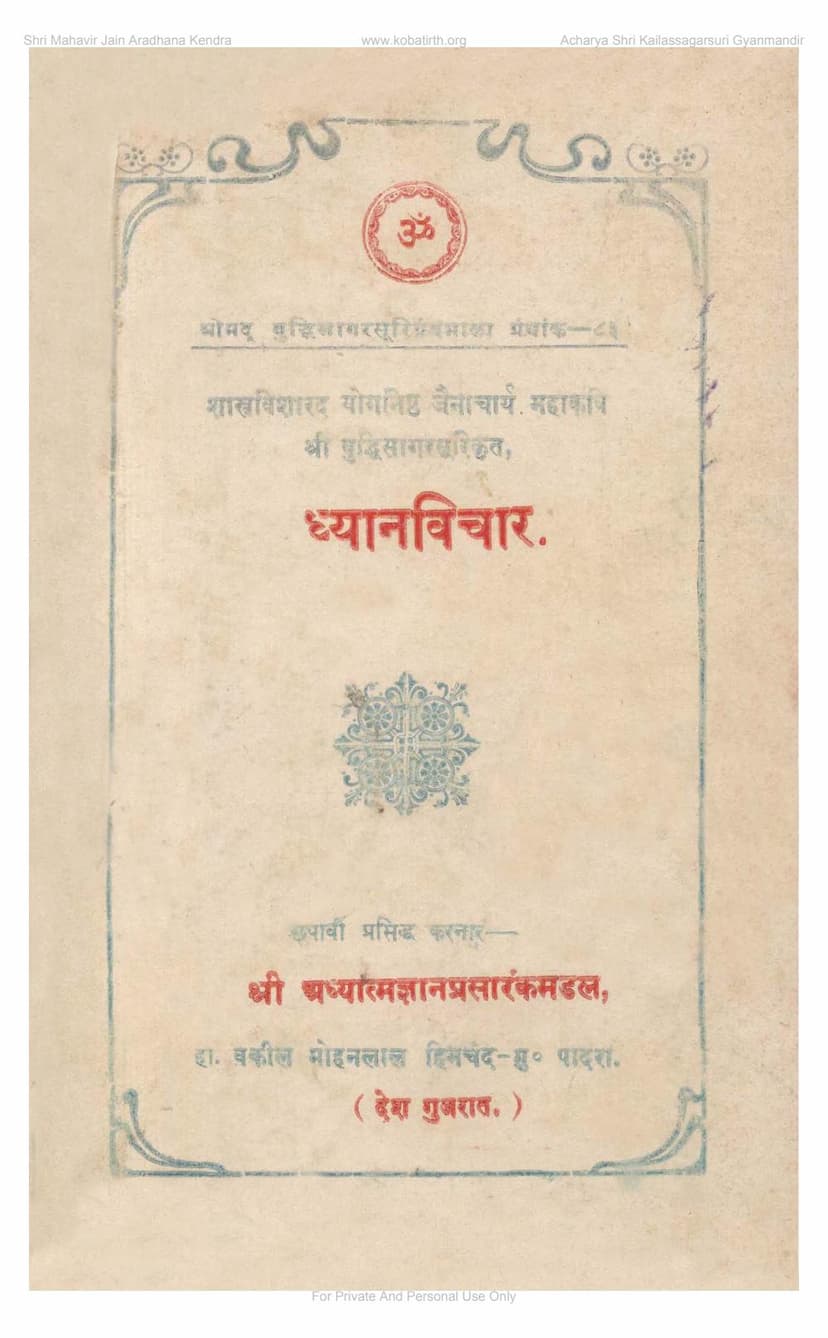Dhyanavichar
Added to library: September 1, 2025

Summary
Here's a comprehensive summary of the Jain text "Dhyanavichar" by Acharya Buddhisagar Suri, based on the provided pages:
Book Title: Dhyanavichar (Meaning: Contemplation/Meditation Discourse) Author: Acharya Buddhisagar Suri Publisher: Adhyatma Gyan Prasarak Mandal Edition: Second Edition (published in Vikram Samvat 1981 / 1924 AD)
Overall Purpose:
"Dhyanavichar" is a Jain text that delves into the concept and practice of meditation (Dhyana) within the framework of Jain philosophy. Its primary aim is to guide individuals, particularly those aspiring for spiritual liberation, towards understanding and practicing righteous meditation. The book emphasizes the importance of meditation for purifying the mind, detaching from worldly desires, and ultimately achieving spiritual emancipation.
Key Concepts and Structure:
The book is structured around the classification and explanation of different types of meditation, their significance, and how to cultivate the beneficial ones.
-
The Four Types of Meditation: The core of the book is the detailed explanation of the four types of meditation as defined in Jainism:
- Artadhyana (Sorrowful Meditation): Characterized by thoughts of loss, suffering, pain, and lamentation. The book describes various scenarios leading to Artadhyana, such as separation from loved ones, loss of possessions, illness, and the fear of death. It highlights how this type of meditation leads to suffering and negative consequences in the afterlife.
- Raudradhyana (Fierce/Angry Meditation): Associated with violence, anger, cruelty, hatred, and malicious intent. The text details forms of Raudradhyana stemming from violence against living beings (animals, humans), deceit, theft, and extreme attachment to material possessions. It emphasizes that this meditation leads to lower realms of existence.
- Dharmadhyana (Righteous/Virtuous Meditation): This is presented as a beneficial and essential form of meditation. It is characterized by thoughts aligned with Dharma (righteousness and virtue). The book elaborates on four sub-categories of Dharmadhyana:
- Ajnavichay (Contemplation of Divine Commands): Reflecting on and internalizing the teachings and commands of the omniscient beings (Jinas).
- Apaya Vichay (Contemplation of Cause and Effect/Karma): Understanding the principles of karma, how actions lead to consequences, and the nature of the soul's journey through different life forms.
- Vipaka Vichay (Contemplation of Karmic Fruits): Reflecting on the results of past actions, both pleasant and unpleasant, and their impact on the present and future lives.
- Sansthan Vichay (Contemplation of the Universe/Cosmology): Meditating on the structure of the universe, the nature of souls, matter, and other fundamental Jain principles. The book also details the twelve Bhavanas (contemplations) as crucial aids to Dharmadhyana, including impermanence, non-attachment, suffering in the cycle of birth and death, purity, and renunciation.
- Shukla Dhyana (Pure/White Meditation): This is the highest form of meditation, leading directly to liberation (Moksha). It is described as a state of intense mental concentration and detachment from all worldly concerns, where the soul experiences its pure nature. The text briefly mentions its four stages: Pruthakvitarka Vicara, Ekavitatarka Avicara, Sukshma Kriya Apratipati, and Ucched Kriya Anivritti.
-
The Importance of Meditation: The book repeatedly stresses that liberation is unattainable without meditation. It is presented as the internal conduct of the soul, essential for the manifestation of omniscience. The text argues that just as a householder cannot be adorned without wealth, a monk cannot be adorned without meditation. It draws examples from Jain history, such as Lord Mahavir's extensive meditation leading to Kevalgnana.
-
Avoiding Negative Meditation: A significant portion of the text is dedicated to explaining why Artadhyana and Raudradhyana must be avoided. These meditations lead to negative karma, suffering, and rebirth in lower realms. The author provides detailed descriptions of actions and thoughts that constitute these negative forms of meditation.
-
Cultivating Dharmadhyana and Shukla Dhyana: The book elaborates on the practices and mental states that lead to Dharmadhyana and ultimately Shukla Dhyana. This includes:
- Adherence to the vows (Mahavratas) and their sub-categories (Bhavanas).
- Understanding and contemplating the Jain principles, scriptures, and the path to liberation.
- Cultivating qualities like equanimity, detachment, compassion, and friendliness.
- The role of scriptures, self-reflection, and the guidance of a Guru.
-
The Nature of the Soul and Karma: The text touches upon the Jain understanding of the soul's nature, its bondage with karma, and the path to shedding these karmic impurities through meditation and righteous conduct.
-
The Jain Universe and Cosmology: The book includes descriptions of the Jain concept of the universe, including the different realms, hells, heavens, and the structure of the cosmos, as a means to foster detachment and provide context for the soul's journey.
-
Practical Guidance: While detailed, the text also offers a practical approach, encouraging readers to study scriptures, reflect deeply, and strive for mental purity through disciplined meditation. It acknowledges the difficulty in fully grasping subtle concepts in the current era but emphasizes the unwavering truth of the Jinas' teachings.
Author's Style and Context:
- Acharya Buddhisagar Suri, a renowned poet and scholar, presents the concepts in a clear, often poetic, and accessible Gujarati language.
- The book is presented as a second edition, indicating its popularity and the demand for its spiritual guidance.
- The dedication for the second edition mentions it is published in memory of Bai Viji, the widow of Shah Bhagubhai Surchand, signifying a tradition of supporting spiritual literature through charitable donations.
- The publisher, Adhyatma Gyan Prasarak Mandal, is dedicated to spreading spiritual knowledge through books.
In essence, "Dhyanavichar" is a profound treatise on Jain meditation, systematically explaining its different forms, the consequences of each, and the path to achieving the highest states of consciousness for spiritual liberation, guided by the principles of the omniscient Tirthankaras.